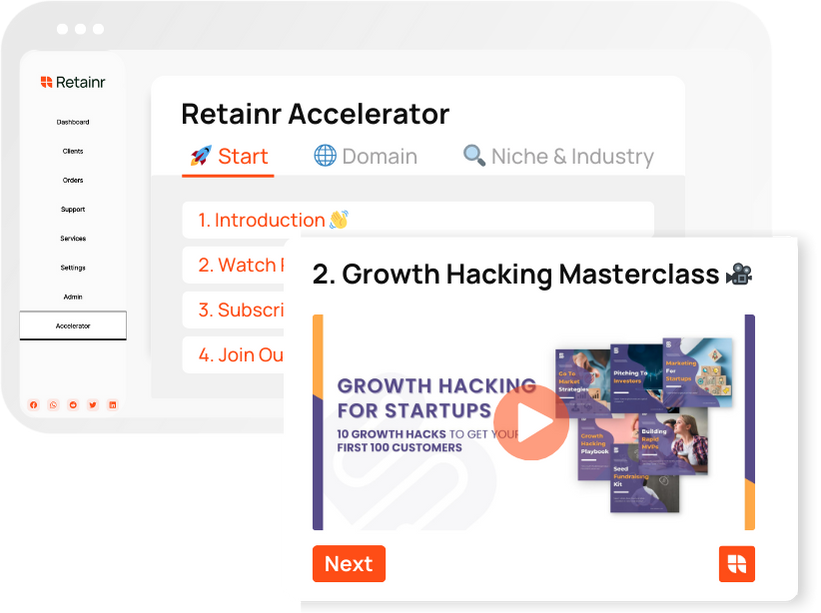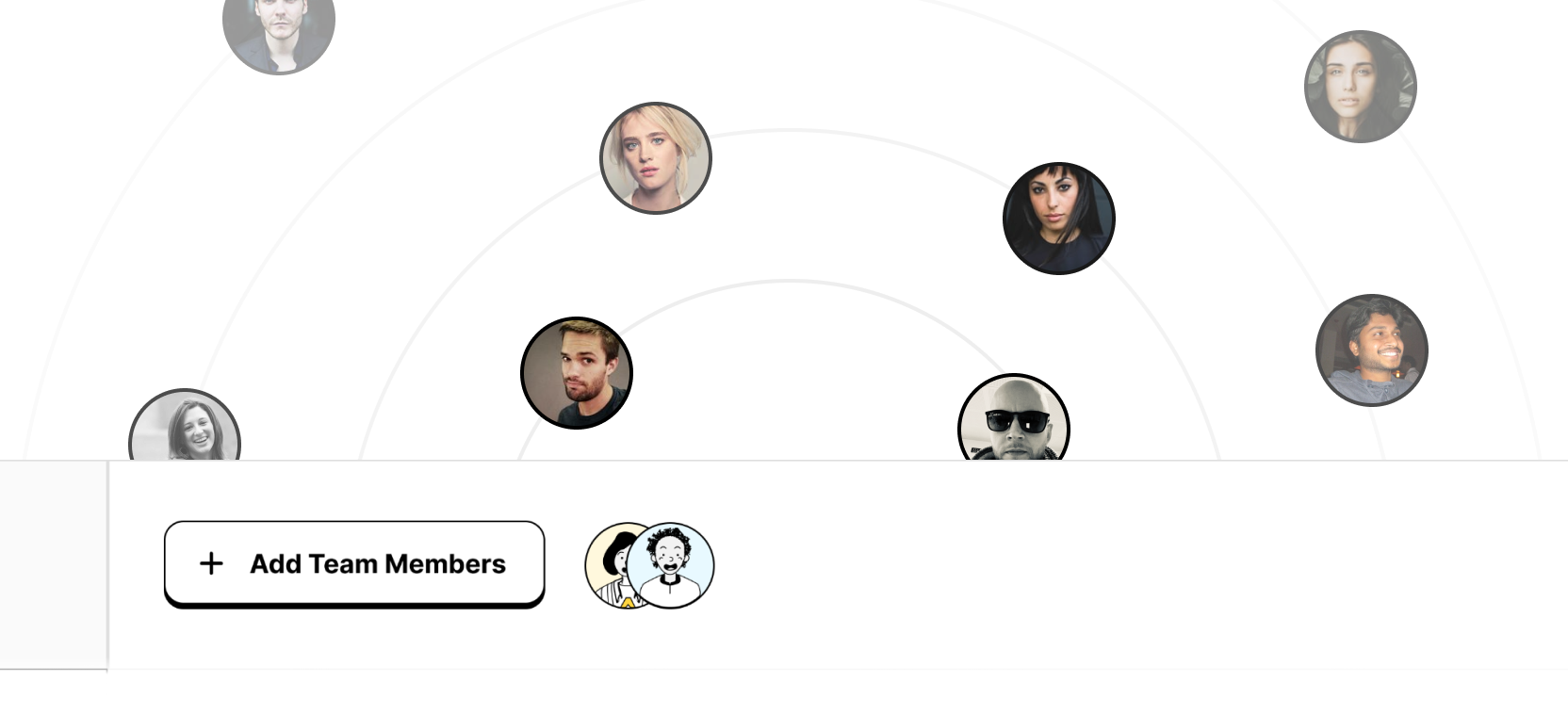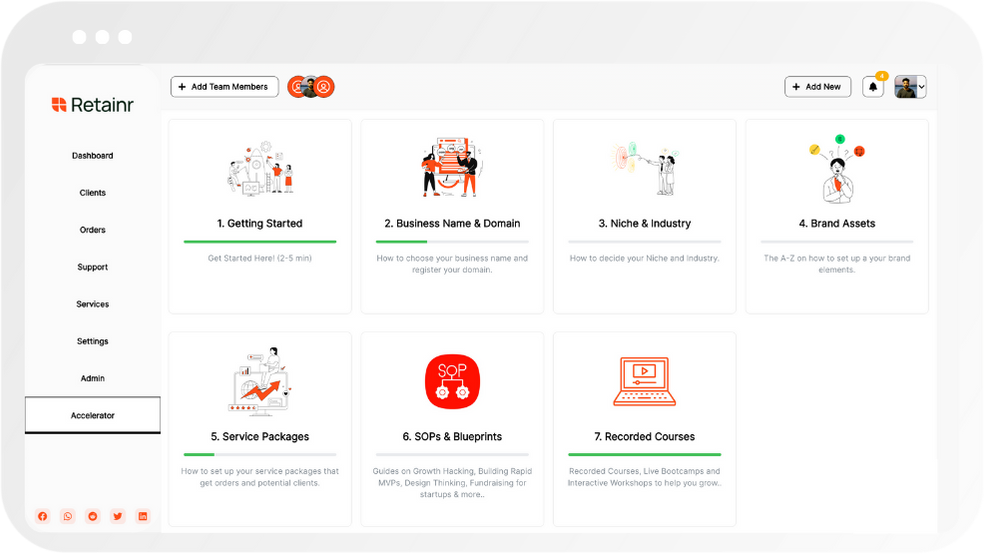
How to Make Money using White-Label Apps
Build with Retainr
Sell your products and services, manage clients, orders, payments, automate your client onboarding and management with your own branded web application.
Get Started1. What are white-label apps and how can they help one make money?
Understanding White-Label Apps
White-label apps are software products created by one company and then purchased and rebranded by another company to make it appear as if they made it. The purchaser can customize the purchased software with their branding style, logo, and identity, allowing these companies to have an app without having to develop it from scratch. This concept significantly reduces the development time and resources and allows any businesses to have their mobile app.
Ways to Make Money With White-Label Apps
There are several ways to generate income using white-label apps:
- Selling the App: The most straightforward method is to sell the app to end users. This could be an upfront one-time purchase, a recurring subscription fee, or even a freemium model where users can download and use the base app for free, then pay for additional features.
- In-App Advertising: Using the app as a platform for other companies' advertisements is another way to monetize. This model works best when you have a substantial user base to show the ads to.
- In-App Purchases: Adding optional in-app purchases is a common monetization strategy for games and other apps, letting users buy digital goods within your app.
Profit Potential of White-Label Apps
Depending on the pricing strategy and the app's target market, the income potential could be significant.
| Pricing Model | Potential Profit |
|---|---|
| One-time purchase | High upfront, but potentially lower overtime without recurring revenue |
| Subscription | Potentially lower upfront but higher potential for long-term revenue |
| Freemium | Depends on the conversion rate of free users to paid users |
| Advertisements | Depends on amount of active users and click-through rate |
| In-app purchases | Depends on user engagement |
2. How much can one potentially earn from using white-label apps?
Earnings from White-Label Apps
The potential earnings from using white-label apps can vary greatly depending on multiple factors. These include the type of app, the level of customization, the market demand, and the target audience. It's worth noting that white-label apps provide an exceptional business opportunity for those who know how to leverage them effectively. Some companies have managed to generate consistent revenue streams that range from a few thousand to several million dollars per year.
Breakdown of Potential Earnings
Let's take a look at potential earnings from a pricing perspective. Typically, companies that offer white-label solutions charge a one-time setup fee ranging between $500 and $5000, alongside a monthly recurring fee ranging from $50 to $300. Suppose that an entrepreneur manages to sell a white-label app to a business at a one-time fee of $2000 and a monthly fee of $150. Here's a simplified earnings table:
| Number of Clients | One-Time Setup Fees | Monthly Recurring Fees | Annual Income |
|---|---|---|---|
| 10 | $20000 ($2000*10) | $18000 ($150*12*10) | $38000 |
| 50 | $100000 ($2000*50) | $90000 ($150*12*50) | $190000 |
| 100 | $200000 ($2000*100) | $180000 ($150*12*100) | $380000 |
Factors Influencing Earnings
- Market Demand: The earnings can be significantly higher if the app caters to sectors where demand for apps is high.
- Level of Customization: Offering custom features can increase the price of the app.
- Target Audience: Higher earnings can be expected if the target audience includes businesses willing to pay a premium for a bespoke app.
3. What is the process to start using white-label apps for income?
The Preparatory Phase
The first step to using white-label apps for income is to decide the type of app you would like to create. It could be a shopping app, a gaming app, a fitness app, etc. Once you've identified your niche, you'll need to research the market and your competition. Identify gaps in the market where your app can spin a difference, and understand the features that app users find most appealing and useful.
| Steps | Description |
|---|---|
| 1. Choose your niche | Determine the type of app you want to create. |
| 2. Market research | Understand the market and competition within your chosen niche. |
| 3. User Preferences | Explore the app features that users find most appealing and useful. |
App Development and Monetization
The next phase is app development. With your research as a foundation, you will enter into a partnership with a white-label app development company. They will handle the technical part of creating the app based on your specifications. You’ll discuss together on the design, layout, platform (Android, iOS, or both) and other crucial features. After development, the app is then marketed aggressively to the target audience. Monetization can be accomplished through methods like in-app purchases, premium features, ads, and subscriptions.
The Launch and Post-Launch Phase
The final phase of this process is to launch the app and then manage post-launch activities. These activities include marketing, feedback collection, regular updates, and customer support. It’s important to keep track of app performance through analytics. It's also worth considering updates to keep the app fresh, resolving bugs, and improving user experience.
| Post-Launch Activities | Description |
|---|---|
| 1. Marketing | Aggressively market the app to increase visibility and downloads. |
| 2. Feedback Collection | Collect and analyze user feedback to improve the app. |
| 3. Updates | Regularly update the app to fix bugs and improve user experience. |
| 4. Customer Support | Provide stellar customer support to retain users and resolve complaints. |
4. Do white-label apps require any special knowledge or skills to make money from them?
Knowledge and Skills Required for White-Label Apps
Indeed, profiting from white-label apps does necessitate a certain degree of understanding and expertise, albeit this doesn't have to be technical in nature. White-label app success hinges on effective marketing and a keen understanding of your customer base. Among the skills required are:
- Marketing expertise: You need to create compelling outreach strategies to promote your app and attract users.
- Customer understanding: A thorough comprehension of your audience's needs, preferences, and pain points aids in offering an app that truly adds value.
- Strategic planning: Effective planning helps in projecting the app in the market and foresee issues that may affect its performance.
While it is true that having technical skills will be helpful, many white-label app providers offer comprehensive support to handle the technical side, making it possible for non-tech savvy individuals to succeed. However, you still might need to understand some technical terms and processes to effectively communicate with your provider and users. Here are a handful of technical skills and knowledge that can be handy:
- Basic Applications Operations: Understanding of basic tech operations like applications installation, update and usability.
- App Analytics: Basic understanding of analytics can help you measure user engagement and app performance.
- App Store Optimization: An understanding of how to optimize your app for visibility in app stores can increase download rate.
Proficiency Levels of App Entrepreneurs
| Entrepreneur Type | Experience Level | Required Skills |
|---|---|---|
| Novice | Low | Basic understanding of app operations, a knack for marketing and sales. |
| Tech-savvy | Intermediate | Strong grip on app operations, experience with app store optimization and analytics. |
| Professional | High | Deep understanding of customer needs, marketing strategies, app operations, analytics, and app store optimization. |
5. Can you elaborate on the business models available for making money from white-label apps?
Freemium Model
The first model is the Freemium model, where you offer the basic version of the app for free, and then charge users for an upgrade to access enhanced features or content. This model is particularly useful for games and productivity apps. The strategy here is to get the users hooked on the free version, thereby increasing the likelihood of them paying for the upgrade. For instance:
- Free version - The user can access standard features and functionality.
- Premium version - Offer additional features, no advertisements, and other benefits in exchange for a fee.
In-App Advertising Model
The next is the In-App Advertising model, which generates revenue via ads placed within the app. This typically means partnering with businesses who wish to advertise their products or services to your user base. This model is especially useful for apps that have a large, active user base. In-app advertising can be categorized into:
| Banners | Ads placed at the top or bottom of the app screen. |
| Interstitial Ads | Full-screen ads that appear at certain points in the app’s flow. |
| Reward Videos | Users are given in-app rewards for watching video ads. |
Paid App Model
The last model is the Paid App model, where users pay a one-time fee to download and use the app. This model usually works best with unique apps that offer exclusive features or content. However, to convince users that your app is worth the investment, you could provide a free trial period or a demo version. For example:
- Regular version - Charge a certain amount for download and complete functionality access.
- Trial or Demo version - Offer limited functionality or time-period for free to give users an idea of the app effectiveness.
6. What types of white-label apps are most profitable?
The Most Profitable White-Label Apps
White-label apps are an excellent way for businesses to launch an app without the costly and time-consuming process of developing one from scratch. By purchasing the rights to brand and customize an existing app, companies can have an app ready to use in a fraction of the normal development time and cost. There are several types of white-label apps that are known to be particularly profitable.
- E-Commerce Apps: With a surge in online shopping, e-commerce apps top the list of most profitable white-label apps. These apps allow businesses to sell their products or services online and can include features like product catalogs, booking systems, and payment gateways.
- Food Delivery Apps: The pandemic has increased the demand for home food deliveries, making food delivery apps highly profitable. These apps can help restaurants and food outlets increase their customer reach and improve their service.
- Fitness and Wellness Apps: Health and wellness have become a major priority for many individuals worldwide. Thus, fitness and wellness apps are in high demand and can be profitable for businesses in the health and wellness sector.
Profitability of Various White-Label Apps
| Type Of App | Profitability |
|---|---|
| E-Commerce Apps | High |
| Food Delivery Apps | Medium to High |
| Fitness & Wellness Apps | Medium |
7. Are there any risks involved in generating income from white-label apps?
Risks Associated with White-Label Apps
The use of white-label apps as an income generating strategy poses potential risks which might hinder a sustainable revenue flow. While lucrative in many ways, it does come laced with pitfalls that any business or individual must take into account before venturing into this income generating strategy.
Financial and Operational Risks
- Unpredictable Development and Maintenance Costs: Costs for app development, regular updates, and maintenance might escalate, thus affecting profitability.
- Quality Assurance: As the app isn't directly developed by your company, you might have no effective control over the quality assurance practices.
- Dependency on Vendor: Being absolutely dependent on the app's original developer for any update or maintenance may lead to operational challenges.
- Security Concerns: There could be potential security gaps as you may not have complete transparency on the data protection measures put in place by the original developer.
Engagement, Branding, and Legal Risks
Further risks arising from the use of white-label apps include:
| Risk | Details |
|---|---|
| Engagement | Without a competent vendor, you may face challenges related to user interface and app functionality, negatively affecting user engagement. |
| Branding | The app might not completely align with your brand, resulting in dissonance and customer dissatisfaction. |
| Legal | There may be unresolved legal issues, including copyright, IP, and non-compliance to data protection laws. |
8. How much does it typically cost to get started with a white-label app?
Initial Costs of White-Label Apps
Setting up a white-label app isn't free, but the actual cost depends on various factors such as the app's complexity, its features, and the white-label provider. However, to give you a rough estimate, the price can range from as low as $1000 to as high as $30,000 for a branded, readymade app. It's crucial to understand, though, that this is a one-time cost which might seem overwhelming at first but proves to be cost-efficient in the long run.
Breakdown of Costs
The cost to start with a white-label app includes several components such as:
- Basic configuration: This includes setting up the app's foundation, layout, and branding. This is a one-time cost included in the initial setup.
- Monthly subscription: Most white-label providers charge a monthly fee in return for services such as hosting, security updates, customer support, etc.
- Additional features: If you want extra features, there might be an additional cost involved. The price depends on the complexity of the feature.
Cost Table
Below is a general breakdown of the costs associated with white-label apps:
| Expense | Cost |
|---|---|
| Basic Configuration | $1000 - $5000 |
| Monthly Subscription | $50 - $200 |
| Additional Features | Dependent on Feature |
Remember, these are estimates and the actual costs can vary. It is also worth noting that the return on investment for a well-implemented white-label application can far outweigh these initial costs.
9. What strategies can one use to increase their income potential with white-label apps?
Develop a Strategic Approach
To increase income potential with white-label apps, it's crucial to develop a strategic approach. This includes selecting the right niche, creating a solid marketing plan, and setting up an effective monetization strategy. A niche that is in high demand and has less competition can be advantageous. Planning your marketing effectively ensures that your white-label app reaches your target audience, while a monetization strategy ensures you generate income from your app.
- Selecting the right niche: Conduct market research to identify trending niches. Proceed to create apps that cater to these niches and serve specific market needs.
- Creating a solid marketing plan: Incorporate various marketing methods like social media marketing, content marketing, and paid advertising to promote your app.
- Setting up an effective monetization strategy: There are various app monetization strategies including in-app purchases, subscriptions, or ad placements. You can also opt for a freemium model to attract more users and offer premium features at a cost.
Provide Value and Maintain Quality
Another strategy to amplify income potential with white-label apps is providing value and maintaining quality. Your chances of making more money increase when users find your app valuable and reliable. Thus, the app needs to solve a problem or cater to a need that will improve the user’s life or business. Continual improvement and updating of the application in terms of features, design and usability is also a necessity.
| Strategies | Description |
|---|---|
| Provide value | Create an app that solves a real problem or satisfies a need in a superior way compared to the competition. |
| Maintain quality | Keep your app up to date with the latest design trends and usability standards, always focusing on user experience. |
Partner Up with Businesses
Partnering up with businesses is a potent strategy to augment your income via white-label apps. This method involves selling your app to businesses that can use it as their own. These businesses obtain a ready-made digital product, save development costs and time, and you earn a profit from selling your white-label app. Furthermore, you can offer customization, maintenance, upgrades, and support services to create an ongoing income stream.
- Selling the app: You can approach businesses that are yet to digitalize, or businesses looking for cost-effective app development solutions.
- Offering additional services: Apart from selling the app, you can offer app customization, updates, and customer support to businesses for an extra cost.
10. Can you give examples of successful entrepreneurs who made money using white-label apps?
Successful Entrepreneurs Who Made Money with White-label Apps
There are numerous entrepreneurs who have effectively leveraged the power of white-label apps to build lucrative businesses. These entrepreneurs operate across different industries, demonstrating the versatility of white-label solutions. Here, we will discuss a few examples.
Success Stories in the On-demand Services Sector
- Rappi: Rappi, a Colombian tech company offering on-demand delivery services, started its operation leveraging a white-label on-demand app solution. The firm quickly scaled up its services across several Latin American countries, and as of 2021, its valuation exceeded $1 billion.
- Go-Jek: Go-Jek, an Indonesian on-demand multi-service platform, used a white-label app to start its operations. The company is now estimated to be worth $10 billion and operates in several South Asian countries.
Success Stories in the E-commerce Sector
In the table below, we have highlighted a couple of key players in the e-commerce sector who developed their business using white-label apps.
| Company | About | Current Valuation |
|---|---|---|
| Zulily | Zulily is an American e-commerce company that sells clothing, toys, and home products. It began as a white-label business before it dramatically scaled and was finally sold to QVC. | $2.4 billion |
| Wayfair | Wayfair is a significant player in the e-commerce industry, offering everything from furniture and home goods to decor and goods for home improvement using a white-label model. | $15 billion |
Conclusion
Embrace the Power of White-Label Apps to Enhance Your Revenue Stream
White-label apps give businesses an opportunity to add a new revenue stream without burdening themselves with the complexities of development, maintenance, and upgrade. These apps are ready-made, customizable platforms that allow you to get started with ease and simplicity. Here is how you can leverage them to make money.
Why Choose White-label Apps?
- Ease of Deployment: White-label apps are ready-to-use platforms that can be rebranded and launched rapidly, saving businesses crucial time and resources.
- Low Upfront Cost: No more straining your finances with costly development processes. With white-label apps, only a license fee is required.
- Focus on Business Growth: Skip the technical hassles, focus precisely on what truly matters – expanding your business.
What's needed next is an ideal white-label software like Retainr.io.
Leverage Retainr.io to Boost Your Earnings
With Retainr.io, managing clients, orders, and payments under your own branded app has never been easier. It is a versatile white-label software that allows you to sell your services with unparalleled ease. The robust features of Retainr.io help you establish a strong relationship with your clients, enhancing their trust and loyalty.
How to Make Money with Retainr.io
- Monetize Your App: Employ various monetization strategies like in-app purchases, subscriptions, or run ads to generate regular revenue.
- Sell the App to Clients: With Retainr.io, you can rebrand the app and sell it dynamic clients across various industries.
- Provide Added Services: Offer value-added services with the app like training and support for a fee.
Elevate your profits and redefine your business identity with Retainr.io.
Boost Your Agency Growth
with Retainr Accelerator
Uncover secrets, strategies, and exclusive blueprints to take your agency's growth to the next level — from marketing insights to effective presentations and leveraging technology.

SOPs, Cheatsheets & Blueprints
Leverage 50+ SOPs (valued over $10K) offering practical guides, scripts, tools, hacks, templates, and cheat sheets to fast-track your startup's growth.
Connect with fellow entrepreneurs, share experiences, and get expert insights within our exclusive Facebook community.
.jpg)

Join a thriving community of growth hackers. Network, collaborate, and learn from like-minded entrepreneurs on a lifelong journey to success.

Gain expertise with recorded Courses, Live Bootcamps and interactive Workshops on topics like growth hacking, copywriting, no-code funnel building, performance marketing and more, taught by seasoned coaches & industry experts.

.jpg)

.jpeg)


